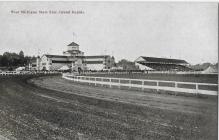
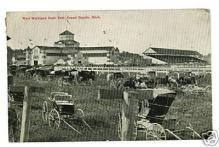

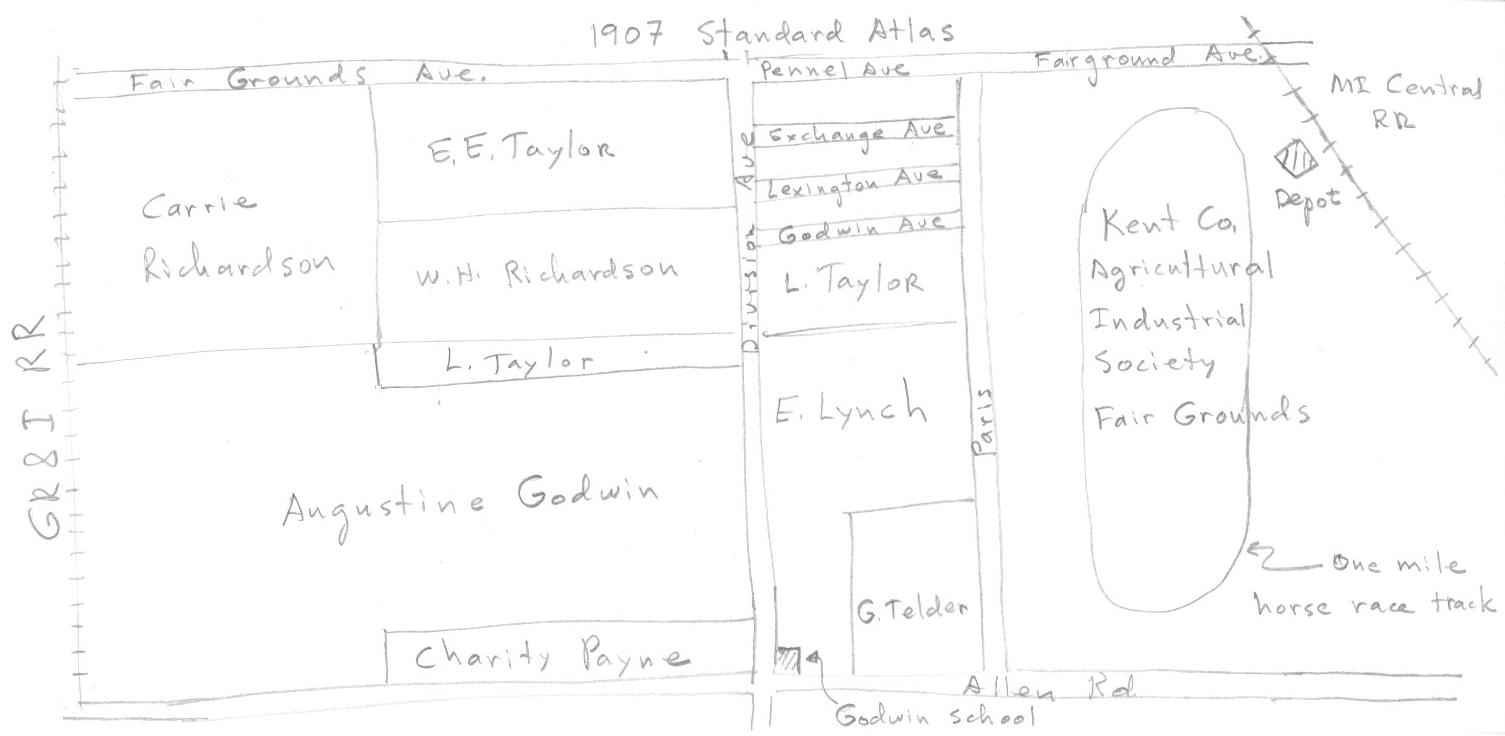
A schematic representation of information taken from a 1907 Standard Atlas of Kent County. Only hinted at in the image, the street names were not only very different in 1907, a street name might change many times as one traveled. For example, notice that what is today 32nd Street was "Fair Grounds Ave." west of Division Avenue, "Pennel Avenue," after a local land owner, briefly to the east of Division Avenue, and then "Fairgrounds Avenue" again. ( Whether both "Fair Grounds" and "Fairgrounds" are used, or one is an oversight, is not clear. )
This situation prevailed until 1943, when a complete overhaul of the street names was done in Kent county. Overlapping names in the various townships had started to make it difficult to navigate in the area as more people owned cars, and travelled further. The situation must have taxed the post office at some point too.
The map shows a small parcel of land, 10 acres, on the northwest corner of Allen ( later 36th ) and Division Avenue, owned in 1907 by Charity Payne. In perhaps 1908 this was purchased by Frank Rackett, and included the house on the corner. Note that Buchanan Avenue did not extend south of about Alger at the time. It would later go along what is the back (west) property lines of the Taylor, Richardson, and Payne farms. Where Frank Rackett moved to the area from, or why, is not known. He sold the 10 acres to Godwin school in 1935, with the stipulation that he could live in the house as long as he wanted, and that the house would stand until he died. One minute after he died, in about June, 1959, the house was demolished.
House locations are not noted on the source map, and in particular it is not known just where the Godwin family house stood, or the Godwin Hotel. So far no photographs have surfaced. The farm consisted of 64 acres. Augustine Godwin, last surviving males in a family of seven brothers, moved off the farm in 1904, with his two daughters, to a house on 542 Jefferson Avenue. Just what happened to the farm after he left, or how long it was before it was platted, is not clear yet. Plat maps made in years after 1907 would show what has happened to the land.
The Kent county Agricultural Industrial Society Fair Grounds
was former further north. As Grand Rapids expanded, the fair
grounds were moved south, presumably to cheaper real estate.
The one mile horse race track is similar to those that could
be seen across America from the 1850s to perhaps the 1920s.
In a pre-TV era, horse racing, and, quite likely, the gambling
that went with it, was a nearly universal pastime.
Left click on the images below for larger versions.

|

|
A depot once stood by the Michigan Central railroad track. Just exactly what kind of stop it was, and when it was removed is not clear. There were things like flag stops in those times, where a single passenger could stop the train to get on. This kind of folksy approach to business was commong at the time, but later on would not be tolerated, as train schedules become tighter.
Completed on January 1, 1870, and originally called the Grand River Valley Railroad, the track stretched 84 miles, from Grand Rapids to Jackson. By the late 1950s, the only passenger service was Budd Cars, and only then because the US Postal Service paid to have mail carried. When that subsidy stopped, there was no longer any passenger service.
The line was operated with a state subsidy until 1984. After a nostalgia run between Grand Rapids and Jackson the tracks were taken out southeast of Kalamazoo and 44th Street. The remaining track served Steelcase, but with the falling fortunes of Steelcase after about year 2002, the line is essentially abandoned today. The rusty tracks, and, during the winter of 2003/2004, the absence of any tracks in the snow indicating the presence of a train, confirm that it is no longer used. It's amusing that some of the depots along the route are still standing. In Hastings for example.
The intersection of Paris and Allen Road is today the intersection of Jefferson Avenue and 36th. At some point the E. Lynch and G. Telder farms were platted - perhaps before 1915, when the Interurban made living in the Godwin area and working in downtown Grand Rapids practical. It's quite possible that the Godwin farm, and other adjoining farms, were also platted about the same time. It's clear that there was a lot of building in the area after the Interurban started running in about 1913.
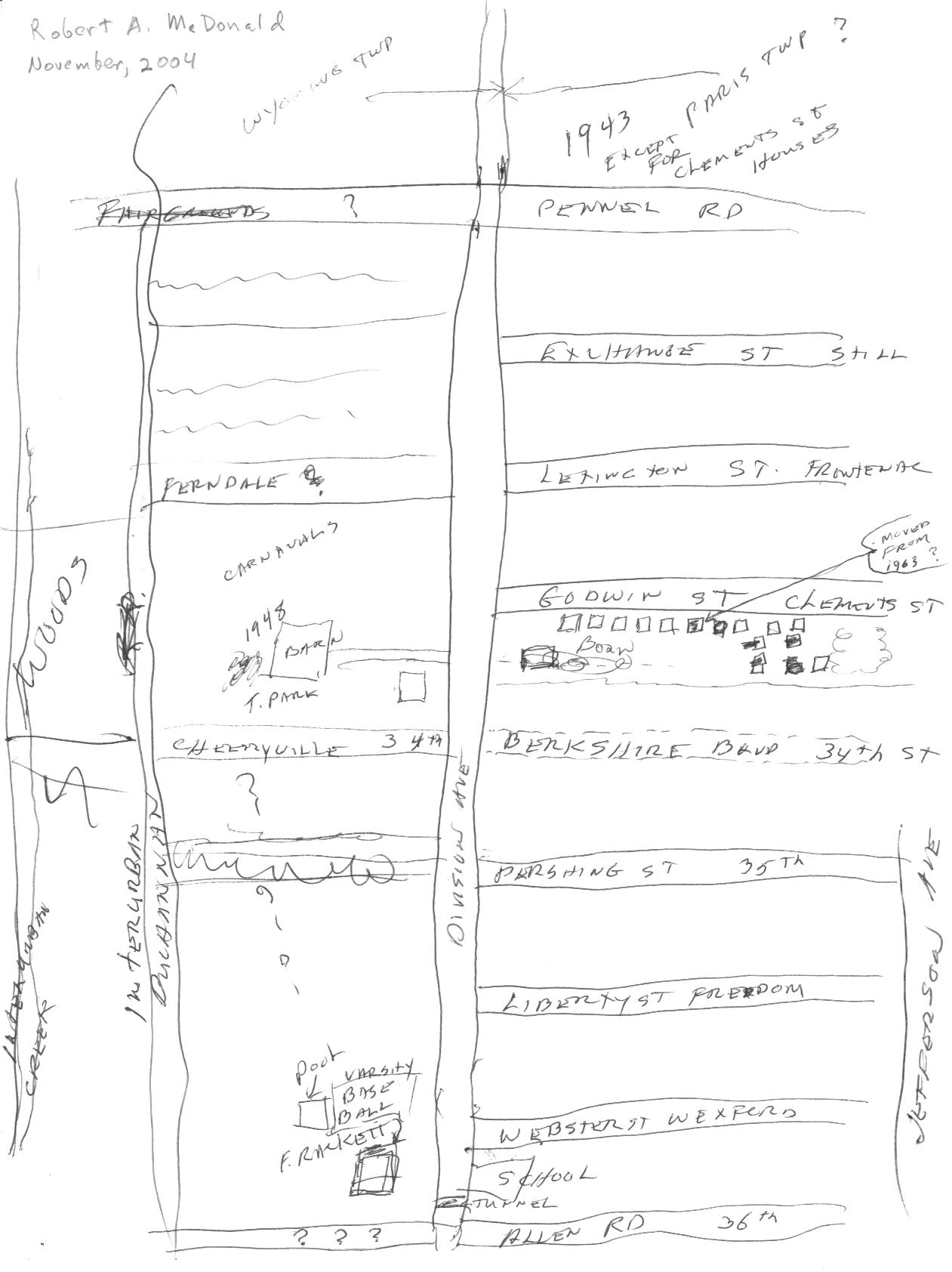
Map of the area north of Godwin around and before 1943 supplied by Robert A. McDonald, class of 1943.
1943 was something of a pivotal year for street names in the Godwin area. The system of street names had become so unwieldly and fluid that some authority, perhaps the county, decided that a more consistent naming scheme should be implemented. This situation was common all over the country, and in many places still is. Street names change at township boundaries for no good reason. Short stretches of road would have a different name every few blocks, reflecting the name of the farmer whose farm bordered the road at that place. In 1907, for example, 32nd Street had about five names between Clyde Park and Eastern (formerly East ) Avenue.
The situation no doubt complicated mail and other kinds of delivery, In addition, street names changed often, reflecting another small change in local politics, and yet someone else wanting a street, or part of a street, named after them. It's possible that WWII put pressure on the need for a more streamlined street naming convention, but of course the changes were no country wide, so it may also have been a more local matter.
The map above, provided by Robert A. McDonald, shows the streets just north and west of Godwin in 1943, and for some period before. Indicated on the map are many of the street name changes. The interurban track actually went about half way between Division Avenue and Buchanan Avenue. Just when Buchanan Avenue was extended south of Alger Street is still not clear.
Of particular interest is the area bounded by what is shown to be Ferndale and Cherryville on the map, and would be 33rd and 34th Streets in 2005. An 1855 Wyoming township map shows (see the right hand edge of the map, about half way down ) that land owned by William Godwin, father of Austine Godwin, after whom Godwin school is named, extended from what is today 36th Street north to 32nd Street, and from Division Avenue to as far west as the Grand Rapids and Indiana railroad tracks. North of what is today 34th Street, Godwin's land extend west to what is today Buchanan Avenue. William Godwin came to Michigan in 1834, and apparently settled on the Godwin land at about that time, making him one of the earliest residents of Wyoming township.
What seems to follow from this is that the farm house that existed up until about 1954 on the west side of Division Avenue, just north of 34th Street, was the Godwin family home. This remains to be confirmed, but the 1855 map does show a house at this location, and the Godwin family owned all the rest of the land around that location. Robert A. McDonald has relatives that lived in the house in the 1920s. Augustine Godwin died in early 1909, and by 1907 already the Godwin land north of 34th Street had been sold, as shown in the 1907 map segment further above. This would then indicate that the family house might have been sold by then. In Augustine Godwin's obituary notice ( Section "G" ) it is mentioned that by 1904 he was living with two daughters at 542 Jefferson Avenue, again suggesting that the family home was no longer used by the Godwin family.
If the house was indeed the Godwin family home, then it was probably well over 100 years old when it burning in about 1954. At what point the property stopped being used for farming is not clear. In the early 1940s already it was the Walbridge trailer park, in which Robert A. McDonald's future wife lived. That existed in to the early 1954, and was disbanded some time around 1955, and the land used to build North Godwin on the northeast corner of 34th Street and Buchanan Avenue, and Arlan's (now long gone), an early discount store, on the northwest corner of 34th Street and Division Avenue.
There was a barn behind the farm house, indicated on the map, which apparently existed until at least 1948. Robart A. McDonald relates that in the early 1930s there was a pit in the barn, and in the pit was a safe. Opened, it contained a lot of canceled checks and other things, but what in detail is no longer known. People were distrustful of banks years ago, and especially in the 1930s. Perhaps the safe was part of a home bank. People were also known to bury money in jars on their property, and in 2005, people with metal detectors will often search around the property of an old house in hopes that something has been forgotten.
Kids used to play baseball behind (west of) the barn, Carnivals were held on the property just south of 33rd Street. Just north of the farm house, and on Division Avenue, was the Bee-Hive restaurant. ( See section "L" for details. )
On the south side of Godwin Street ( later, Clements Street ) the McDonald family owned the first ten houses, starting at Division Avenue. As new family members reached the point of needing a home, they would add a house.
West of Buchanan Avenue was the last remaining stand of woods in the immediate Godwin area. Called Buchanan woods, it was, sadly, used as a local dump. Starting in about 1949, the woods were plowed under, and houses put up. Behind Buchanan Avenue, Birchwood and Hillcroft Avenues were extended north of 34th Street. Equal distance form the Grand Rapids and Indiana railroad track and Hillcroft Avenue a stream ran through the woods. Before the General Motors plant was completed in 1936 there was a substantial swamp around where the Grand Rapids and Indiana railroad track crossed 36th Street. The stream, emanating from the swamp, and paralleling the railroad tracks to Plaster Creek, was said to be a trout stream, as was Plaster Creek itself until raw sewage was dumped into it starting about 1938.
There must have been a fair amount of turmoil for a while after the complete overhaul of street names all over Kent County. Many mail addresses had to be changed. Existing maps would be mostly obsolete.
The 1950's saw the intersection with a gas station on every corner. Eastern and 44th Street for example. Gas wars. There barely was a Middle East, and oil was under a dollar a barrel at the well head. Words like conservation were for spoil sports.
Although the mainland was never attacked during WWII (One Japanese bomb, delivered by a balloon, landed on the ground in Oregon or Washington, but didn't explode. It did after a boy proceeded to throw rocks at it, killing most of one family. ), the U.S. nevertheless saw its skies lit up with anti-aircraft search lights during the 1950's, to announce almost every opening of a new gas station, and later carnivals and other grand openings or special events. WWII surplus, probably with few other uses, the beams of light, more dramatic if it was slightly foggy or overcast, attracted people like moths to get a free glass or a case of coke at a steep discount with every tankful.
It's not clear what happened to them. Perhaps the FAA made it illegal to light up the skies in this way. Perhaps they simply wore out, and were too expensive to repair. But it's been many decades since a beam of light has been seen anywhere.
The following items are from the November 26, 1947 issue of the Live Wire (the name of the school newspaper in and around 1947): "In 1928 the Godwin student body voted blue and gold as the official school colors" "Madelin Crandall and Naomi Doxtator Dietrich wrote the words for the Godwin school song in 1930" "The Godwin football field was constructed in 1937, being one of the first fields with electric lights?"
(Material provided by Lee Nuegent, class of 1948)
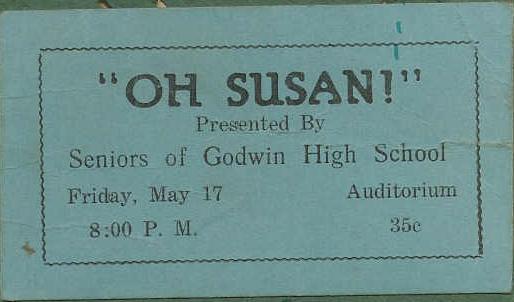
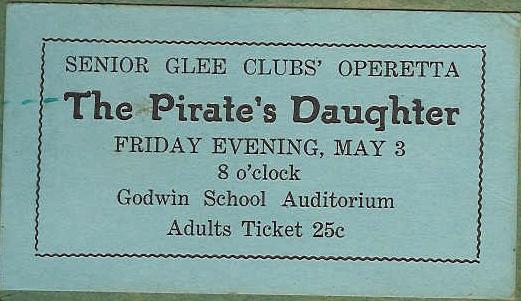
Material provided by Lea (Tanner) Collins, class of 1941, and Alta May (McConnell) Kaiser, would have been class of 1929.

Material provided by the Laubscher family.
A more or less blue and gold pair of dance tickets. Other than 10-cents, and the color, it's not clear what the difference between the two is. Perhaps the yellow ticket is for a single, and the blue for a couple. Or maybe a blue ticket first, and a yellow one for a date.GODWIN HEIGHTS PUBLIC SCHOOLS: FACTS OF INTEREST FROM THE PAST (No date or author listed.) At one time an old toll gate was located on the corner of 36th and Division where the Godwin School Administration Building now stands. The date was about 1856. The purpose was to collect toll from travelers going down the old plank road, now Division. Godwin Public Schols were named for Augustine Godwin, son of William R. Godwin, one of the original Grand Valley Pioneers and the first Supervisor of Wyoming Township, Augustine was one of 11 children. John Wesley Pennell was another pioneer active in the affairs of Godwin School District. Riley Cole was one of the first school officers and owned land on the northeast corner of Freedom Street. Another man active in the district was John Hughes. Wright C. Allen for whom Allen Road, now 36th Street, was named, was director for the district for a term and later treasurer. The first school house which served the communities was built on the S.E. corner of Clyde Park and 36th Street. It is believed to have opened in the year of 1843. The school house was built by Mr. Potter and was a long, low one room building made of rough boards. Imagine a scene in the first school house Students seats about on the traditional straight-backed benches, trying to concentrate on the work at hand. A large oblong box-like stove with a circular drum above it to radiate more heat stood near the front of the room. On the cold winter mornings a circle of pupils gather around the stove, rubbing their hands, and slowly turning all sides to the heat like a barbecue spinning on a spit. Shelves were placed on the front on either side of the entrance and it was lined with various types of dinner pails. Colorful hand woven coats, scarves and caps streamed from the pegs put up for the purpose. In the corner near the door, stands a block of wood, on which sits an old tin pail with a dipper in it. During the morning students vie for the honor of "Passing the water around" and everyone used the same dipper. The water had been carried from the nearest well perhaps a quarter of a mile away. The boards on the floor were knotty and rough and the cracks let in coolness from underneath the school house. The Clyde Park and 36th Street School moved across the road but finally was abandoned when it was decided that the school system was inadequate to supply needs of the district. There was need of a more central location. This marked the beginning of the Godwin School District-Fractional School District Number Six of the Townships of Paris and Wyoming. On April 27, 1867 the joint board of school inspectors of Paris and Wyoming met in the Godwin Hotel, Augustine Godwin was Chairman of the Meeting, and wrote the legal document that officially organized the school district. Fifty one voters were notified as prescribed by the document. The voters met on the 6th of May, 1867, at the Godwin Hotel and elected officers. The first school board was composed of John Wesley Pennell, Riley Cole and Cyrus Jones. A meeting was held May 21, 1867 at the Godwin House and they voted unaminously to build a school house that summer. The site chosen for the first school building was the south corner of 36th and Division by the toll gate. The cost of the building was not to exceed $1500. On September 3, 1867, the first annual meeting was held and the most important business was to vote to raise an additional $427.72 over the $1500, for the purpose of finishing the school house. They also voted to buy twenty cords of wood from the lowest bidder for heating. Abraham Giddie bid $35.00 and was given the contract. The chose the site fo the present library building, the northeast corner of 36th and Division and purchased the land from Riley Cole for $475. He was also hired to clear the ground, build a fence and leave all the shade trees standing with the work to be completed in two weeks. The building was built of brick. Drinking water was provided for when David Laraway was paid $15.00 for digging and bricking up a well. Records show that all necessary equipment was provided for. Orders were drawn on the treasurer for the purchase of a teacher's chair, desk, register, a clock, ink sinks, chalk, broom and tin cup. One very special purchase was that of a bell for $100. The bell rope was replaced twice a year. The school was completed in time for the winter term. The first teacher was Charley Howard who taught for $1 a day. In 1882, the board found it advisable to have uniform text books. Following books were adopted, Harper's Geography, Arithmetics and Readers, Scotts' U.S. History, Harrington's Speller, and Hookers Book of Nature. In 1909 a partion was built and placed through the center of the building. Thus the district grew into a two room school with two teachers. In July of 1923 the school board voted to build an eight room school. The new building was completed and ready for occupancy in January 1925. The architect was J. and G. Daverman Company. This second school building was added to and remodeled and was the core for the present Junior High building. A stone of the original Godwin School building was preserved and placed above the front door of the new building. It is on the extreme northern position of the building and faces Division Avenue. At this time Charles C. Saur was engaged as the Superintendent. There was a staff of seven teachers and the school covered the first 10 grades. The rapid growth of the community caused an addition the very next year and the eleventh grade was added. And yet another building had to be built. In 1926 the 12th grade was added and Godwin on the University list. In June 1927, Godwin School graduated its first high school class consisting of five girls!!! The first eighth grade graduation was held with 25 students. This was also the first time that Godwin gave its own examination. Previously the county had taken care of examinations. In 1929 a new high school building, the core of the present building was constructed. In the spring of 1938, a new building was constructed, a WPA Project. For several years Godwin was recognized as the largest rural school in the country. Through the efforts of Godwin's Frank Rackett, a taxidermist, the Godwin School system has the largest school museum of stuffed birds in the country. It was donated by Frank Rackett and is housed in the library basement. Rackett swimming pool, built out of doors, was the first in the area. On May 12, 1950, Superintendent Saur informed the Board that he would retire. Harold S. Chambers took over the duties. Since that time Godwin School District has grown to include West Godwin on the corner of 36th and Clyde Park, North Godwin on Buchanan and 34th Street, South Godwin on Bellevue and Division. While Roscoe C. Miner was Superintendent, in 1957, the school was in danger of loosing its accreditation because of inadequate gym facilities. Mrs. Robert Ford, while attending a Board meeting proposed that a new gym be built. The voters rejected this first bond issue issue. At this point in Godwin's history an unbelievable effort was made by members of the community to alter that defeat. A large force of citizens, led by Mrs. Robert E. Love, called on the homeowners of the area. They were armed with petitions and facts about the new Physical Education Building. By explaining how inexpensive such a building would be, considering the large amount of tax dollars contributed by area industries, the eager workers acquired many resident's signatures. Signatures alone do not build buildings, however. The petitions were presented to the five man Board demanding another vote. After another election on May 14, 1957 the bond issue for West Godwin Elementary additions, remodeling the high school, and a new Physical Education Building was passed by a 2-1 majority. Thus, Godwin became the first school in the area to have such a magnificent buidling, complete with Olympic-sized pool, gym with a 3400 seating capacity, band room, individual band practice rooms, and a dirt floor practice area. It fast became a community center which has been enjoyed by thousands in the Grand Rapids area. At the June election growing pains necessitated the expansion of the School Board from five to seven members. In 1961 a new addition was needed for South Godwin Elementary. The remodeling of the Division Avenue Elementary School into a Junior High School took place during the summer of 1962. The original Godwin PTA was formed in 1922. In 1928 a milk program was established to furnish milk to all underweight children. During the war years the PTA held most meetings in the afternoon and omitted refreshments. This saved light, fuel and rationed foods. The Godwin Band and Orchestra Association was formed in 1939. The Administration building at 36th and Division was completed in May of 1959 on the site of the former home of Frank Rackett.
(Material provided by Jennifer Godwin.)

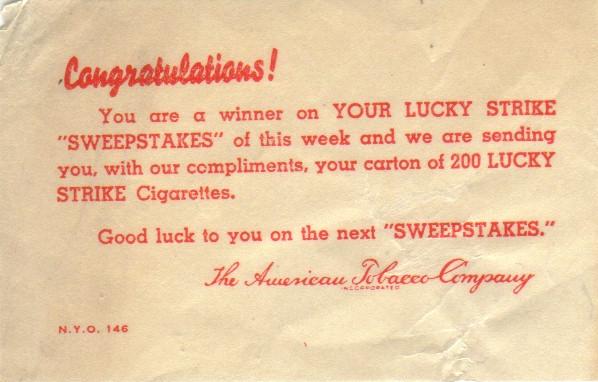
Material provided by the Laubscher family.
From around 1936, the details of contest are not completely known - e.g, how old you had to be to enter the contest - but it is a reminder that in the 1930s, and for fully three more decades, cigarette companies pulled ever stunt in the book to hook young smokers. Plausibly hiding the health consequences the industry knew or suspected, almost every adult smoked at the time, and it was almost a given that a young person would start.
Today this entire concept suggests another era. With the better understanding of the consequences of smoking today, it can only be viewed as a form of slow suicide.
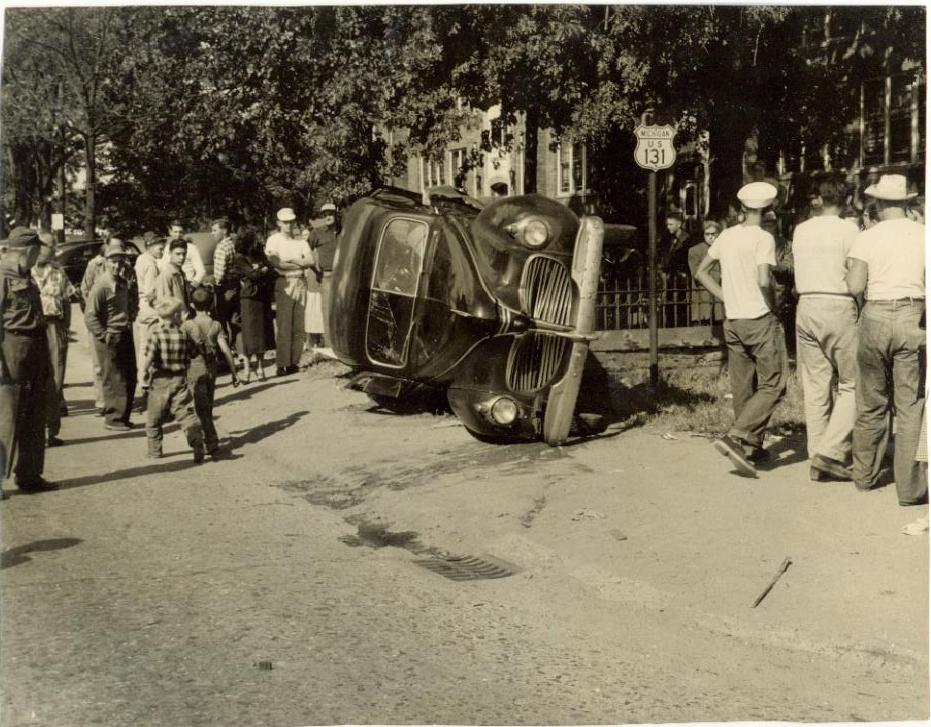
( Photograph provided by Lewis Lull, class of 1940, scanned by Craig Lull, class of 1970. )
An auto wreck near the underpass, on Division Avenue. Dick Speas, class of 1948, lived not far from the intersection of 36th Street and Division Avenue. Close enough in fact to hear accidents happen, and he was able to observe the consequences of a number of them. He believes the one in the photograph ocurred in 1942, and involved a 1940 Plymouth. Dick says he is the person just to the right of the "Michigan U.S. 131" sign, in the white shirt, sailor hat and Levis. It's interesting to see that the car is pointing in the wrong direction at this point, in addition to being on its side. It's tempting to conclude cars were built stronger in those days. Even the windshield seems to be intact.
Left click on the image below for a larger version.
Photograph provided by Lee Smith, class of 1953.
The photograph above was taken in front of the business of A. Buikema and Son(s), 3828 Division Avenue. From the vintage of the cars the wreck might have occured around 1940 to 1945. Given the length of the shadows, and the leaves on the trees, the time was probably 7PM or later. Was A. Buikema related to John Buikema, owner of Buikema's Hardware?
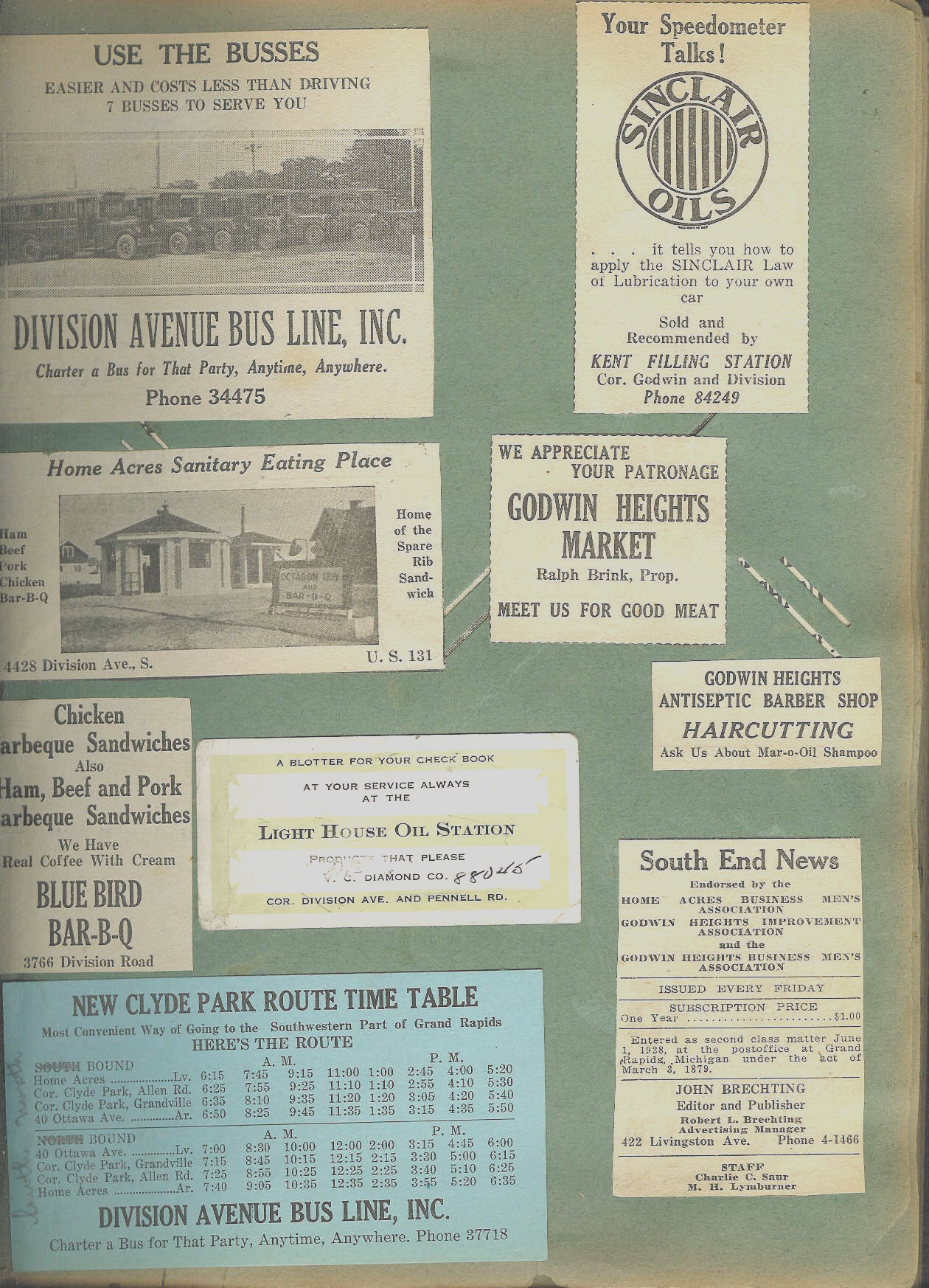
( Photograph provided by Lee (Tanner) Collins, class of 1941. )
Ads from 1929.
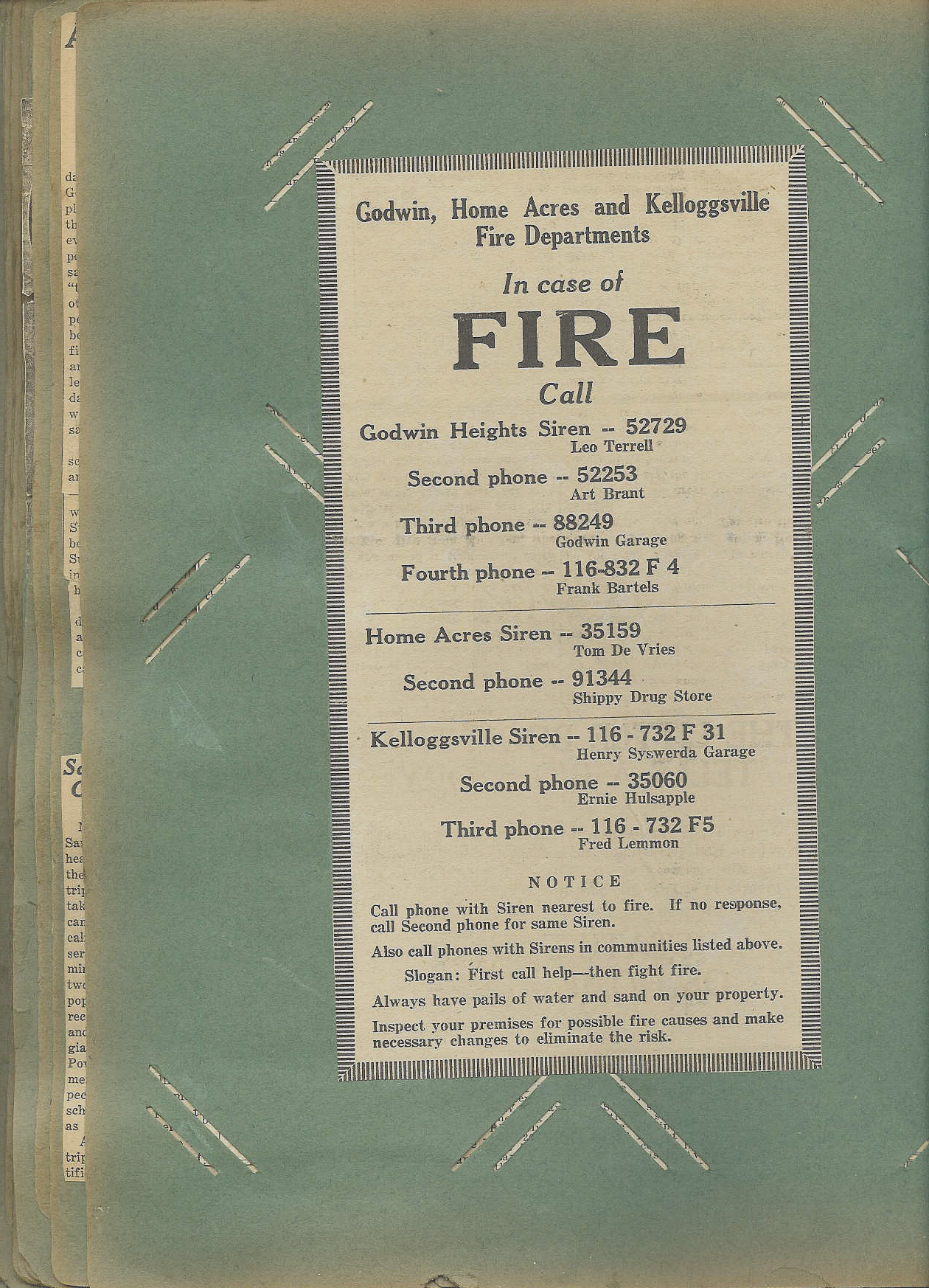
( Provided by Alta May Keiser, class of 1929 ( did not graduate ), who collected the material, Lee (Tanner) Collins, class of 1941, and Joanne Dulyea Hamilton, class of 1951, and the daughter of Alta May Keiser. )
1929 fire department information.
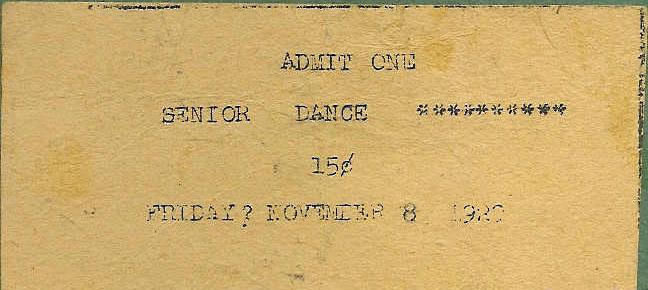
( Provided by Alta May Keiser, class of 1929 ( did not graduate ), who collected the material, Lee (Tanner) Collins, class of 1941, and Joanne Dulyea Hamilton, class of 1951, and the daughter of Alta May Keiser. )
The 15 cent ticket price has to be put in the context of the Depression, which had started just the month before, although not everyone knew it yet. And an annual salary of perhaps $2,000 to $3,000 for many, if they were still employed. 15 cents would be about $1.50 to $2 in year 2000.
Left click on the item below for a larger version.
The ad above is from "The Godwin High School News" of October 20, 1933. In 1933 yet people in the Godwin area were still having to be sold on the idea of the convenience of a telephone. Not every business listed a phone number. And Godwin Heights Plumbing Co., at 3647 S. Division in 1933 already, used a 5 digit phone number: 39969.
Over the next two or three decades, Michigan Bell became a familiar name to most people, and a fine place to work for many a Godwin graduate. In about 1984 AT&T was broken up, and Michigan Bell became part of one of the pieces, Ameritech. This was then absorbed by SBC. Ironically, in 2006 SBC absorbed the original AT&T, and has changed its name to AT&T. As yet, however, there is no Michigan Bell again.


( Photograph provided by Lee (Tanner) Collins, class of 1941. )
Ads and prices from around 1950. Clearly a penny was still worth keeping in your pocket. The area has by now almost outgrown five digit phone numbers. The GL-endale exchange was now in use. CH-erry would follow. Fifty years later the exchange names are gone. Area codes are so numerous now that they are no longer suggestive of any geographical area, and will likely lose their significance, in favor of simply assigning 10 digit phone numbers.


( Provided by Alta May Keiser, class of 1929 ( did not graduate ), who collected the material, Lee (Tanner) Collins, class of 1941, and Joanne Dulyea Hamilton, class of 1951. )
Left click on the image below for a larger version.
The image above shows the house in year 2011. The street west of Division Avenue, north of 32nd, and south of 28th, have been kept up very well for the most part.

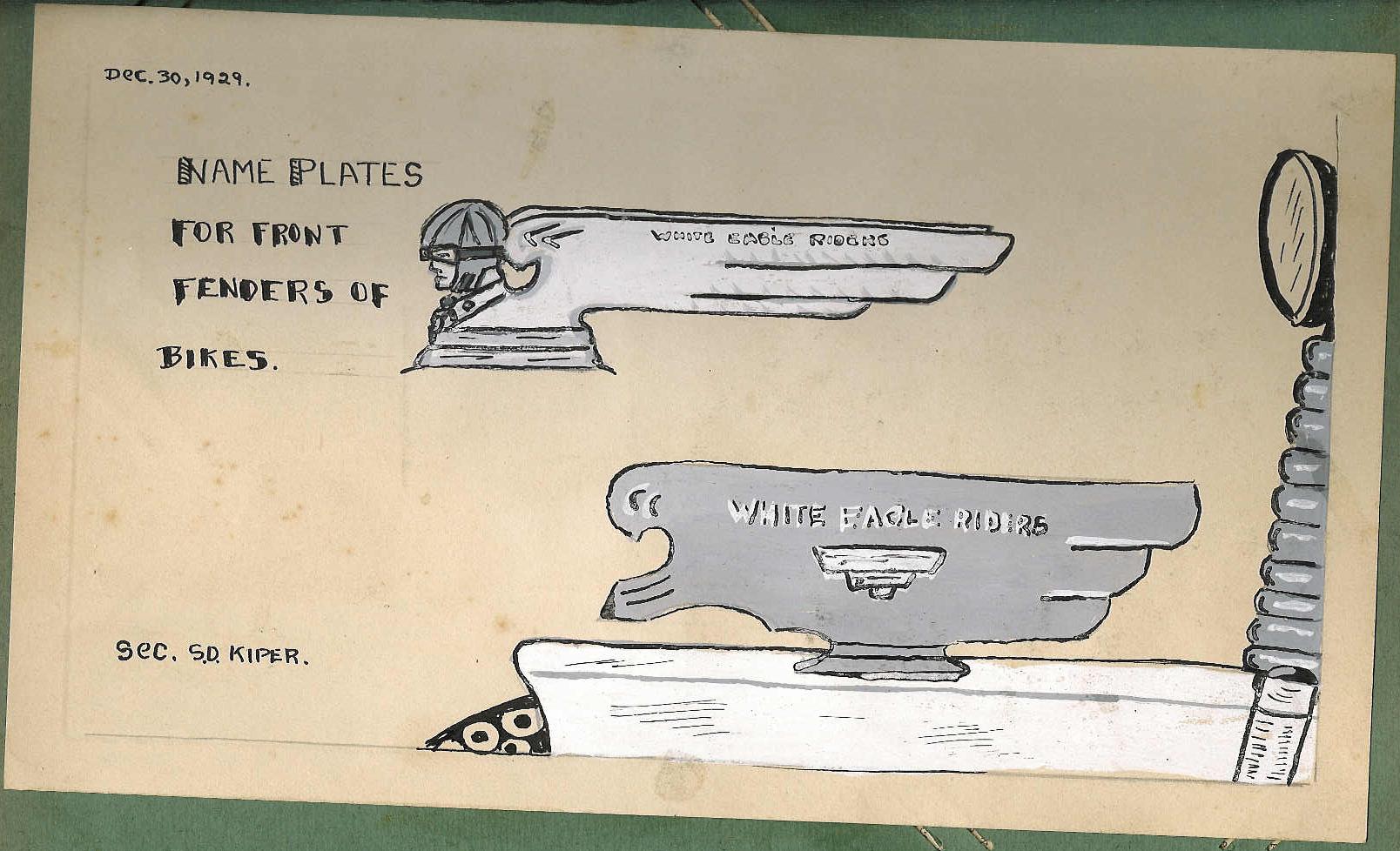
( Provided by Alta May Keiser, class of 1929 ( did not graduate ), who collected the material, Lee (Tanner) Collins, class of 1941, and Joanne Dulyea Hamilton, class of 1951. )
It's not clear whether the notice above is a student business or some kind of school activity.

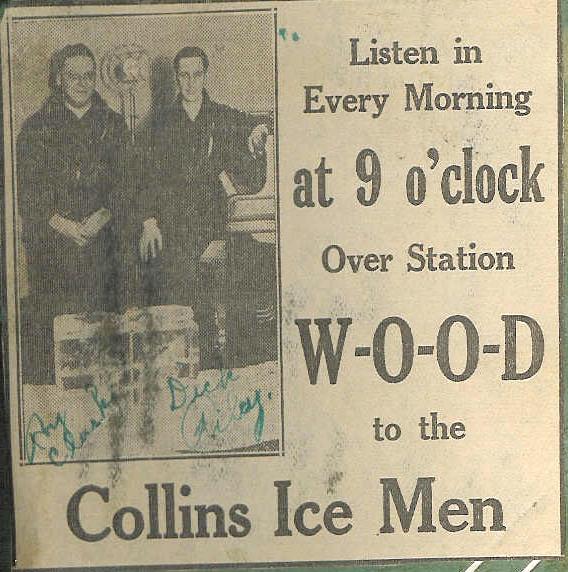
( Provided by Alta May Keiser, class of 1929 ( did not graduate ), who collected the material, Lee (Tanner) Collins, class of 1941, and Joanne Dulyea Hamilton, class of 1951. )
WOOD radio is still alive and well as of year 2003. Less can be said about the forests in and around Grand Rapids, or the furniture industry which depended on it. Otherwise WOOD radio remains a local institution.


Material provided by the Laubscher family.
Scouting was another activity popular at Godwin in the days when there were still a number of farms and open land available to support it. By the 1960s scouting was being declared a paramilitary activity, no doubt influenced by the national Vietnam mentality, and went into serious decline. Reflecting a desire to recapture some of the values scouting represented, it has come back some, but in form today more appropriate for suburban settings. Even so, the emphasis on self reliance and preparedness, however instilled, are values still recognized as desirable by many.

Material provided by the Laubscher family.
The Civic Auditorium, a Great Depression public works project, was perhaps two or three years old when the 1935 concert season started, and occupied the ground where the passenger shed for the Grand Rapids and Kalamazoo interurban system stood. It was always something of a puzzle years ago to see a bridge across the Grand River run right into the side of the Civic Auditorium. Now that the Civic Auditorium has been razed, the bridge serves as a pedestrian foot bridge.
The Abert Smith that is listed under violins in the personnel section of the program is likely the same person that taught music at Godwin around the same time. His wife was a member of the chours of the Grand Rapids Symphony.
Left click on the image below for a larger version.
In addition to the movies, 3-D comic books appeared briefly, using the same glasses. As indicated above, the fad did not last long. Like movies in year 2006, which are often simply vehicles for special effects, and mostly devoid of plots, the 3-D movies mostly revolved around the 3-D scenes, and had little else to recommend them.
As interesting as the 3-D glasses is the fact that in the early 1950s yet people dressed up to go to the movies, and for things like attending church, or a funeral. Almost nothing disrupts slob attire in year 2006.
Left click on the image below for a larger version.
Ann Landers, birth name Esther Pauline Friedman, dispensed social advice to society's lost and disoriented in a newspaper column that debued October 16, 1955, and apparently lasted up to the time she died in 2002, at age 83. Dispensing advice was probably more of a newspaper thing in 1955 when the column began, and was no doubt made somewhat easier by a society that seemed to have rules, even while it too treated rules as something to be broken. So Anna Landers could compare reader's questions with society's expectations, and more or less come up with appropriate advice, something her sister Pauline, a.k.a. "Dear Abby," did in a somewhat competitive manner.
Ann Landers was a staple for millions for decades. In more recent times, her job must have become enormously more complicated as barriers concerning just about everything came down, and a society based on anything goes emerged.
Left click on the image below for a larger version.
Prior to about 1965 there was a substanial slope as Burlingame Avenue approached 28th Street from the south. A geological structure in the form of a long ridge ended at Burlingame, coming from the west. On the top of the hill sat the home of J.B.Ward, a Godwin teacher. Refusing to move, he insisted the city of Wyoming build a new road to his house, which cost something like $6,500 - perhaps $50,000 in the dollars of year 2012.
At some point the entire ridge was flattened, and Ward's house demolished. Few in year 2012 could imagine that such an event took place.

Miller's Field, located at about 5400 S. Division Avenue in the 1930s, ( Who was Miller? ) hosted what might be called company softball teams. The item below shows the teams of Basch Jewelry and Holwerda Dairy square off on August 21, 1937. These games too show a sense of community, as even small shops and companies got out a team, and people played ball with their coworkers on a hot August day, in a time when air conditioning was unknown outside businesses like theaters.


The fate of Miller's Field is unknown here. Like Bigelow Field, it likely succumbed to the pressures of the TV era, which started in the late 1940s. This, and the emergence of home air conditioning, meant that people were more and more inclined to stay home in the evening. In year 2006 the notion of a small business like a jewelry story hosting a softball team no doubt seems quaint.

Material made available for scanning by Lillian Annis, class of 1941.
Sisters Ann Landers and Dear Abby were institutions in the 1950s. The October 4, 1958, installment of Dear Abby gives the flavor of the columns. Almost laughably naive by 2007 standards, they were nevertheless must reading each day for millions.
Oddly enough, despite seemingly to routinely solve other people's problems, the two sisters did not get along much themselves. Becoming a statistic herself, Ann Landers eventually divorced. To what extent their advice to others helped is unknown, but it did seem to be entertaining.

Left click on the image below for a larger version.
Material supplied by John Kamsta, a local collector.
In the 1950s and 1960s, grocery stores and gas stations in particular promoted the notion of buying products in installments. Dictionaries and tableware were common examples. People were encouraged to frequent the same store or chain of stores in order to obtain an installment when the time came. Melmac was an example. An early, durable plastic, fitting of the 1950s with its TV dinners and other attempts to reduce the time needed to maintain a house, it probably reduced the care needed to use and wash family hairloom sets of dishes. It could be knocked around and dropped while being washed with little fear of breakage. In year 2008 and equivalent might be something like Rubbermaid cups and dishes.

Up until the 1880s or even later water wheels powered mills used for grinding, and, less commonly in the Wyoming area, for powering machinery. A dam was typically used to raise the water level, and this was used to turn a water wheel. The mills were relatively common 150 years ago. A mill in Jennison, built in 1864, survived until 1963, when it was demolished to make room for a bank, after efforts to give it to the Ford Museum in Dearborn came to nothing.
The following piece describes an early mill on Buck Creek.
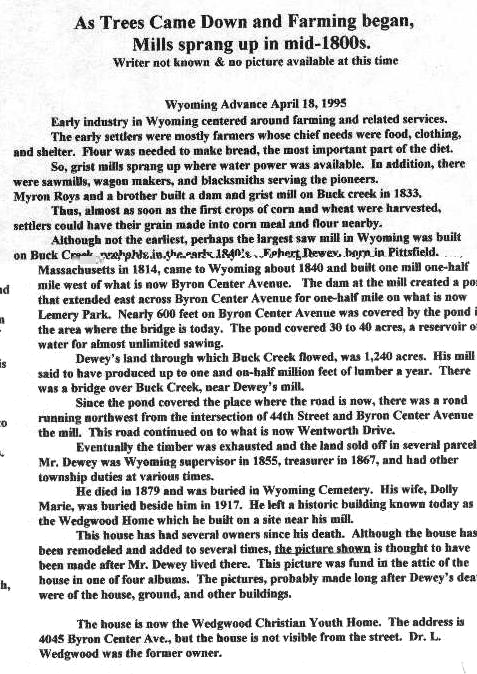
Material provided by Lee (Tanner) Collins, class of 1941.

Material supplied by LeRoy Rockwell, class of 1959.
Material supplied by LeRoy Rockwell, class of 1959.
The Cascade was located at US 16 and M 37, and was operated by Mr. and Mrs. R. Miedema. The site is now occupied by a Lowes store. As shown in the postcard image, it appears to be quite new, given that the trees are newly planted.
Like most motels of the 1950s, it advertised air conditioning and TV. Many early motels initially charged for TV, which were coin operated. Eventally free TV became another competitive advantage.
Material supplied by LeRoy Rockwell, class of 1959.
Howard Johnson's motel chain, like its restarurants, were very popular in 1950s and 1960s, usually combining a motel, or "motor lodge," with a restaurant. As the image above shows, some were two story, which began to diminish the advantages of having one's car right outside for easy loading.
In time the chain was began to lose its family appeal, and more and more became a truck stop. This was the fate of many motels and motel chains as the US interstate system generated vastly more truck traffic in the US.

Left click on the image below for a larger version.
1960-1961 Student council.
Top row: Emily Hylkema, Mary Jane Sack, Judy Bond.
2nd row: Tom O'Donnell, Jan Vonk, John Bazaire.
3rd row: Bob Traetz, Ben Emdin, Dave Harmson, Chet Bush
Bottom row: Kathy Allen, Joyce Koerner.

Left click on either image for a larger version.
Material provided for scanning by LeRoy Rockwell, class of 1959.
The postcard above of Madison Square is postmarked September 5, 1911, so the photograph is at least that old. Many of the buildings appear to be relatively new. It is an era when awnings are common - why this practice largely ended is unclear. The street is dirt, which would be commonly the case until asphalt becomes easily available. Important streets like Division Avenue were paved with concrete in 1924, at least by Godwin Heights. It does appear the sidewalks are concrete. The poles appear to be telephone poles. There is no indication that the area has electricity yet, although it was coming to many areas in 1911. The original photograph would almost certainly show more detail.

